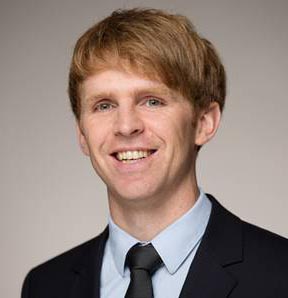17/07/2017
Print PageResearcher portrait: School of Oncology Fellow Dr Martin Niklas – Making particle bombardment visible in cancer cells

Particle therapy systems are gigantic. The gantry at the Heidelberg Ion Beam Therapy Center (HIT) is a steel structure 25 meters long that weighs 670 tonnes. A particle accelerator with a diameter of 13 meters rotates around the patient.
However, with the naked eye it is difficult to see what happens during treatment. Ions, minuscule particles, are fired at the tumor at high speed and with a high level of accuracy. For physicians, this relatively new treatment method is one of the most significant accomplishments in cancer medicine: even if tumors are buried deep inside the body, only the tumor is destroyed. The surrounding tissue remains largely untouched.
For precise targeting, the radiation dose has to be tailored to each patient’s tumor. “So it is particularly important to understand how many particles you need to destroy a tumor completely, and how individual cancer cells react when they are hit,” explains Dr Martin Niklas, a young researcher at the DKTK School of Oncology. As part of his doctoral research, the physicist developed a technique for making the particles’ path through the tumor cells visible, making it possible to see what effect they have in the cancer cells. In close collaboration with University Hospital Heidelberg, his DKTK project group developed a kind of dosimeter with living cancer cells. The cells grow on an aluminum oxide plate, which makes the impact of the individual ions visible. Under the microscope, the researchers can then observe the molecular reaction to each individual hit. “It’s an unparalleled technique that allows us to demonstrate at the nanometer level where an individual cell has been hit and whether, for instance, the DNA has been damaged and which hits are deadly for the cells,” says Niklas.
Niklas’s professional experience and unusual career path appear ideal for developing innovative medical technology. As an IT electronics engineer at Siemens, he studied physics through evening classes. Having completed his doctorate, he studied human medicine on the side and recently took his state exam. Anyone who talks to Niklas about his work senses the enthusiasm that drives his research: “I wanted to get out of heavy industry and develop something that helps people. With my varied background I can approach biomedical and technical research questions from completely different angles.” His project involves physicians, physicists and biologists. “I really appreciate the interdisciplinary collaboration within the DKTK. You can think in completely new directions,” says Niklas.
Having demonstrated that the biosensor technique works, the team is now focusing on answering specific questions. The idea is to use the biosensor to learn about the ‘bystander effect’ – where neighboring healthy cells are sometimes damaged even though they were not hit by the particles. The researchers also want to know whether cancer cells react differently to ion bombardment after chemotherapy. Biosensors with patient-specific tissue are particularly interesting when it comes to personalized radiation therapy. “We are already working out how to cultivate biopsies on the biosensor, but at the moment it’s still a dream,” says Niklas. “Our main aim is to use the results on the dose-effect relationship to develop new clinical standards so that treatment can be planned in a way that is as effective as possible and as gentle as possible on the patient.”